So Much – LIFE !
Are the drops on the leaves and blades of grass from dew or last night’s rainfall? It doesn’t matter. They reflect the morning sunlight as though a thousand prisms had been scattered about. Photographers are told the best time to experience the most favorable light outdoors is an hour before and after sunrise and sunset – “The Golden Hour”. This was more like “The Rainbow Hour”.
Gini said the landscape looked like it was wearing its finest diamonds. Just for us.
Bending down on a knee to get a lower angle on a butterfly resulted in a soaked pant leg. Sitting for a moment to focus on a damselfly resulted in – well, you know.
We had stopped at the Tenoroc Public Use Area Headquarters to sign in and get our permit for the day. Great staff! Always friendly and helpful. We almost have them trained, now. The majority of visitors here are fishermen. When they ask “What lake?” and I answer “We’re here birding today”, they look up with a momentary blank stare. “Oh, yeah! Just a second and I’ll print your pass.”
With over 7,000 acres (2800+ ha) as our playground, we try to follow a bit of a plan on each visit as it would be impossible to explore all of that area in a day, much less a morning. Do we go “birding” only or search for dragons and damsels? But butterflies and moths are abundant! Flora? Wild pigs, turtles, alligators – all with new babies in tow?
It’s a dilemma.
In which case, we just make (sorry about this) – “dilemmanade”!
My old Air Force comrades would refer to our situation something like: “Target is LIMPKIN. Exploit other Targets Of Opportunity to fullest extent.”
We had multiple Targets Of Opportunity to exploit.
Summer in sub-tropical Florida means rain. We have been getting regularly scheduled thunderstorms daily beginning in mid-afternoon. Early mornings are warm and humid but I happen to like that combination. (Native Floridian disease.) By around 10:00, even the rocks start wilting. We usually head for the house before high noon melts the tires off the vehicle.
There are actually a good number of birds to be found in the hot months. Many of them have finished breeding and are busy teaching youngsters how to fly, find bugs and avoid predators. Molting is in full swing for some species and the resulting hot mess of straggly feathers should not be photographed just out of simple courtesy. So, when possible, we strive to find birds to grace our image sensor. Otherwise, we are easily distracted by all the other goodies Mother Nature lays before us.
Our initial route took us to a horseshoe-shaped lake with a path around it. The sun began to dry the foliage and insects became active as they sought a spot from which they could dry themselves as quickly as possible. Small bugs know better than to remain in the open for very long or else they become a meal.
The normal cast of characters began to appear. Once again, we were amazed at the diversity of life all around us! From small flowers and damselflies, to hedgerows and butterflies, to 60-foot tall oak trees and raptors – truly marvelous!
A small sampling from the first half of the morning.
We had heard the characteristic calls of Black-bellied Whistling-Ducks and spotted one foraging along the lake shore. They always seem to have a “just groomed” appearance.

Just a little longer in the sunshine and this Little Yellow (Pyrisitia lisa) will be dry enough to fly efficiently and begin its day.

A Barred Yellow (Eurema daira) will take a little longer to lose its droplets but it has a more sheltered, and shaded, perch to keep it somewhat hidden.

Full sun has helped to thoroughly dry a Dorantes Longtail (Urbanus dorantes) and he’ll soon be flitting very quickly from bloom to bloom in the never-ending quest for nectar.

Somewhat unusual for a moth, the Ornate Bella Moth (Utetheisa ornatrix) is active during daylight hours. Gini sees owl faces in the moth’s intricate wing pattern.
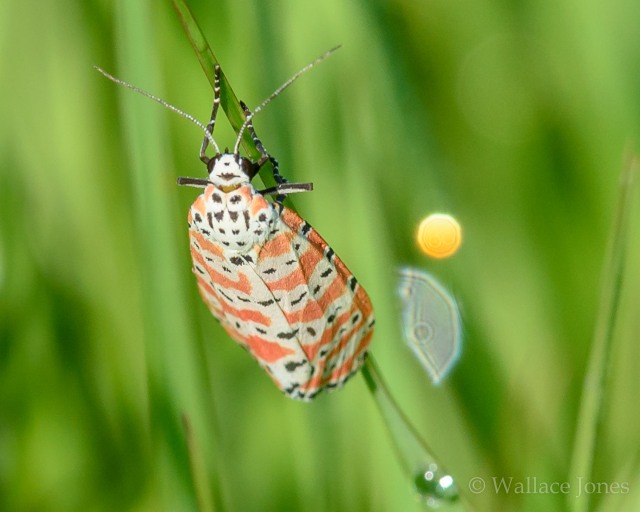
A couple of tips on identifying this female Needham’s Skimmer (Libellula needham) from the nearly identical Golden-winged Skimmer (Libellula auripennis). The pale portion of the Needham’s thorax extends into the dark front area but does not in the Golden-winged. Also, the Golden-winged hind tibiae are black but are brown in Needham’s. Yes, there will be a test later.

A very striking wing pattern identifies the Halloween Pennant (Celithemis eponina).
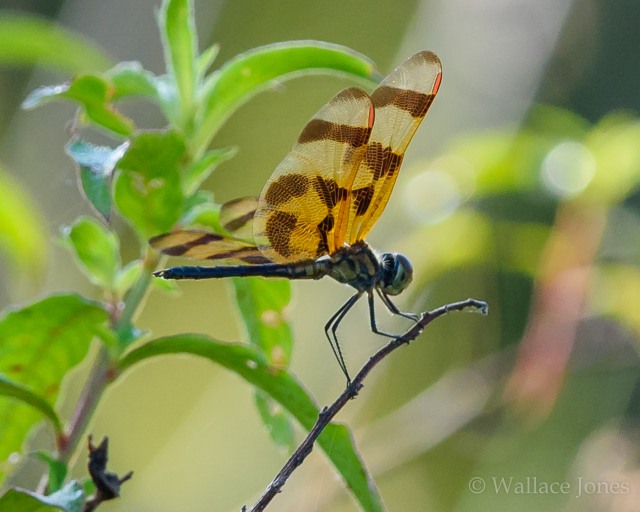
Rambur’s Forktail (Ischnura ramburii) is one of our most common damselflies. The female has two color forms, a heteromorph with orange thorax and no blue at the end of the abdomen and an andromorph which is colored the same as the male. The andromorph female is the lower damsel in the image.
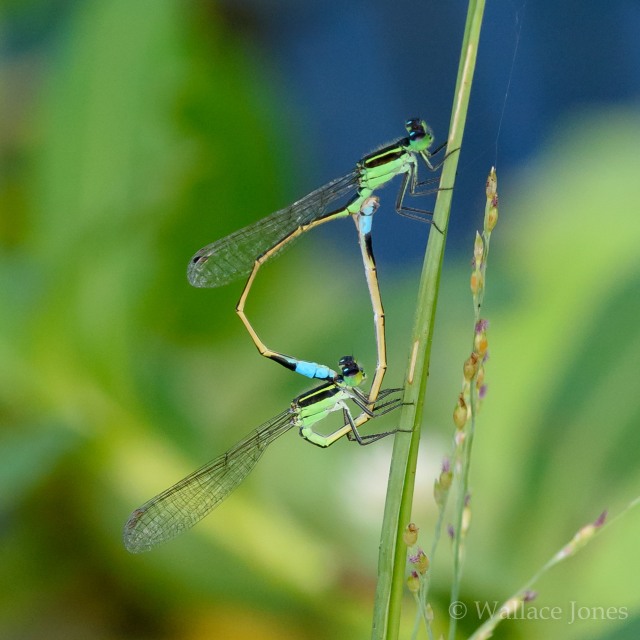
It’s neat to get a photograph of more than one species in a single photograph. Here, a Limpkin shares a bit of shoreline weeds with a White Ibis.

Pretty small at 7/16 inch (11 mm), this Ceraunus Blue (Hemiargus ceraunus) is easy to overlook as my big feet tromp through the weeds. Luckily, it was high enough on a piece of grass to be seen before being stomped. One day, I’ll get a shot of its beautiful dark blue upper side. One day …
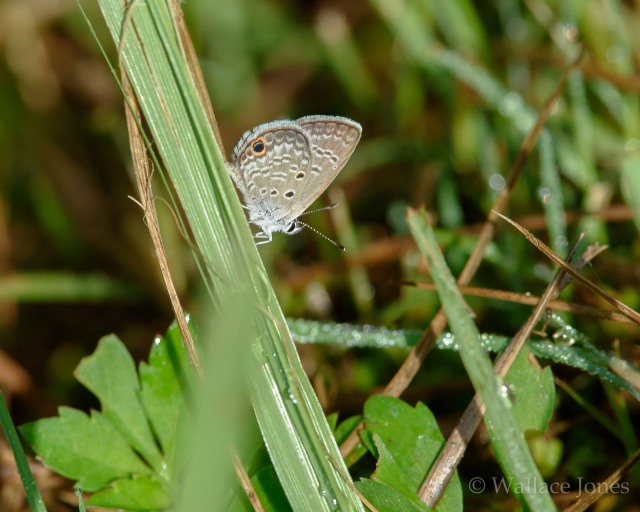
A new species! Hooray! Twenty-two species of Hairstreak (Theclinae) occur in Florida. Most of these we have NOT yet seen. Today, we found a White M Hairstreak (Parrhasius m album). Typical of this species, it was active about 20 feet up in the tree canopy.
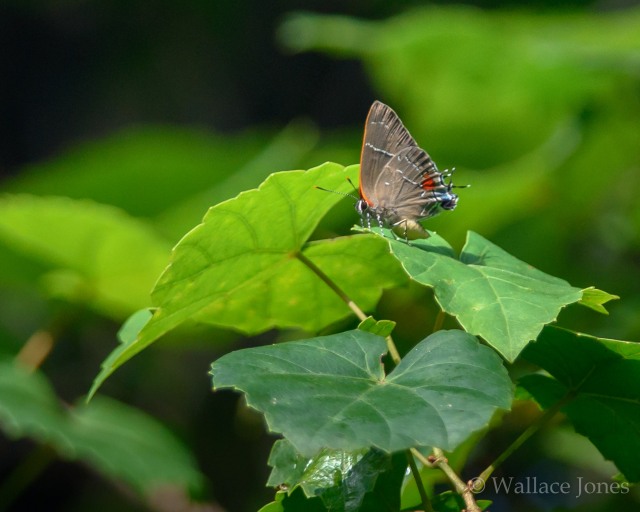
Grass-skippers have been described as the LBJ’s of the butterfly world. (Little Brown Jobs) Here, an orange-colored male Whirlabout (Polites vibex) posed nicely. The female is darker brown/gray.
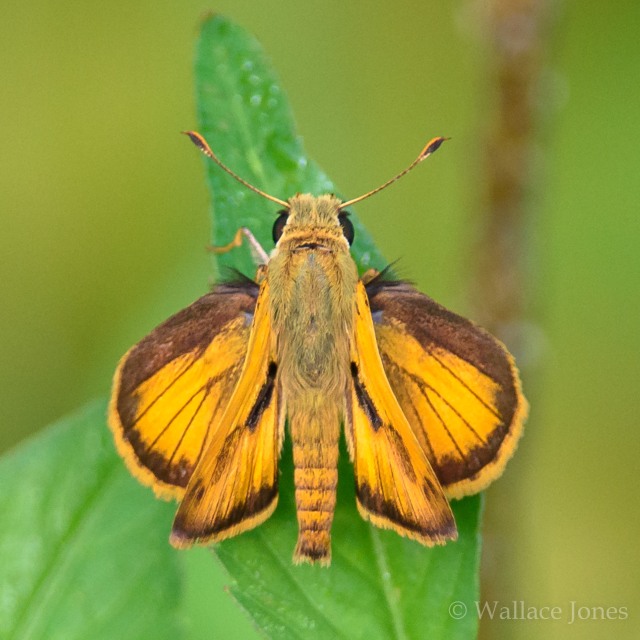
Another grass-skipper, the Clouded Skipper (Lerema accius) male and female are similar in appearance.

Slim abdomen, dark thorax and characteristic wing spots identify a male Four-spotted Pennant (Brachymesia gravida).

So geographically diverse, the Variable Dancer (Argia fumipennis) is the only North American odonate to be given subspecies common names. This specimen, Argia fumipennis atra, occurring in the Florida peninsula, is also known as the Black Dancer.

The sun is well and truly up and droplets are vaporizing, much to the delight of the insect world. As the insects become more active, there are some happy birds in nearby trees. While they contemplate what to have for breakfast, Gini and I shall pause and enjoy our own repast. Peanut butter and jelly sandwiches may be plebeian, but right now they sure will taste good!
Stay tuned for the remainder of our morning visit where we find even more LIFE!
(Header image is a Tricolored Heron at dawn.)
Enjoy your search for a natural place and come back for a visit!
Hello Wally,
I always enjoy your nature post, the photos are just stunning. I love all the birds, moths, dragons and damsels. Thank you for linking up and sharing your post. Enjoy your day, wishing you a great new week ahead. PS, thank for the comment and visit.
LikeLike
Your very nice comments are much appreciated, Eileen.
LikeLiked by 1 person
Hello. Wonderful serie. Awesome photos. Thank you.
LikeLike
Thank you very much, Anu!
LikeLike
Oh to be spoilt by 7,000 acres, wild pigs, turtles, alligators and birds!
I must admit, the dragons and nymphs stole the show today Wally. Now that’s some admission from someone that’s 99% a birder I think?
Loved the Ornate Bella Moth especially, so unusual; and those delicate pennants are delightful.
As ever my friend, I’m impressed by your encyclopaedic knowledge of all things creepy to be found in those natural places.
Stay happy you both.
LikeLike
We fully admit to being spoilt.
Careful, Phil, about the bugs. We don’t want to be the cause of your drifting over to the “dark side”.
No matter what the rest of the world is up to, we have never had an issue with staying happy!
Thank you for continuing to say such nice things.
LikeLike
Super shots, Wally, of such a wide variety of dragonflies, damselflies, and butterflies, only a few of which were familiar to me.
LikeLike
Thank you, Mike!
More to come …
LikeLike
Text not appearing but hopeyou can read this. I must be using a white font against a white background. Your narrative was entertaining and very informative. I have not seen hairstreaks here in our local patch– maybe I am looking for them too close to the ground.. Hope you can see this
LikeLike
Your text appears just fine, Ken.
Thank you for your nice comments! Yes, I discovered a lot of butterflies and dragonflies spend a lot of time higher in the trees than I thought!
LikeLike
I am in agreement with other comments, Wally. Your header just stops me in my tracks. What a diorama that is. It goes without saying that all of your pictures maintain a very high standard and each one bears close scrutiny. My favourite, however, is the shot of the Limpkin and the White Ibis together. That seems to encapsulate Florida wetlands, with two incredibly interesting birds. Well done with this whole post!
LikeLike
Thank you, David.
A habit I’m trying to break – taking close-ups only of birds, totally ignoring their habitat. A work in progress …
LikeLike
That is a superb selection of butters and dragons Wally. Thanks for taking me along.
LikeLike
Glad to have you aboard any time, Brian!
(Sure beats settling into a new home ……)
LikeLiked by 1 person
You certainly did make delightful “dilemmanade” in this target rich environment! Well done!
LikeLike
Thank you very much, Ed, for the kind comments.
The weekend is over already??
LikeLike
Had a bit of difficuly getting past that fabulous header image, Wally! Glad I made it through, however, as, once again, you have delighted me with your words and wonderful images of dragons, butterflies and a moth – I can see where Gini’s coming from with seeing owls on the wings of that moth, but I’m seeing a very clear owl on top of its thorax!
Interestingly, our female Ischnura damselflies also come in different colour-forms.
Loved your two bird images too!
Suddenlly our heat has gone and it has been raining all day – wonderful!!!!
Very best wishes to you both. Take good care and stay safe – – – Richard
LikeLike
Happy you made it past that header, Richard! We sometimes just stand there with our mouths open at a beautiful sunrise setting.
Good news that your heat spell has broken, Can Autumn be far away?
All is fabulous here in the sub-tropics and we hope you and Lindsay have a terrific new week!
LikeLike
Hello,
Beautiful post and photos. One of my favorites is the whistling duck. You are lucky to live so close to all this beauty and the wildlife. Take care, enjoy your day! Have a great new week ahead!
LikeLike
We sure do appreciate your nice comments, Eileen! Yep, we are truly blessed. Looking forward to the new week and all the good things it will bring.
LikeLiked by 1 person
Lucky, lucky, lucky.
You and Gini of course – and us because you share the beauty and the wonder. Thank you.
LikeLike
Life is all about sharing. Thank you, EC.
LikeLike
The dragonflies and butterflies are wonderful …you must hypnotize them…they never ever hold still for me! (And I never see so many beautiful ones anyway). One of my favorite things s to get more than one species of birds in one photo! Sallie
LikeLike